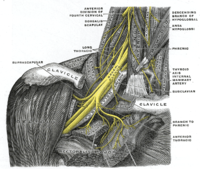
Photo from wikipedia
The aim of this study was to evaluate ex vivo the sealing achieved at simulated lateral canals (SLC) and the quality of filling according to their position in the root… Click to show full abstract
The aim of this study was to evaluate ex vivo the sealing achieved at simulated lateral canals (SLC) and the quality of filling according to their position in the root canal after using the same filling technique. SLC were created at three levels in 55 teeth and divided into two groups depending on the root canal sealer used (1: BioRoot® RCS, 2: GuttaFlow® bioseal). They filled them with the continuous wave technique and submitted to a diaphanization technique. The samples were analyzed using a magnifying lens (20×), pictures were taken, which proceeded to linear measurement with the ImageJ® program and used a filling score system with five grades (0 to 4, 0 and 1 not acceptable, 2 to 4 acceptable); BioRoot® RCS has got a greater proportion than GuttaFlow® bioseal for SLC filled acceptably at 10 mm from the apex (p < 0.05). The highest proportion of SLC filled acceptably was found in the middle third (6 mm) (p < 0.05), followed by the apical third (3 mm) and the coronal third (10 mm). The difference between apical and coronal third could be significant; BioRoot® RCS has been better than GuttaFlow® bioseal for filling SLC in the coronal third of the teeth. Studies on the characteristics of these cements are missing to explain these differences.
Journal Title: Applied Sciences
Year Published: 2021
Link to full text (if available)
Share on Social Media: Sign Up to like & get
recommendations!